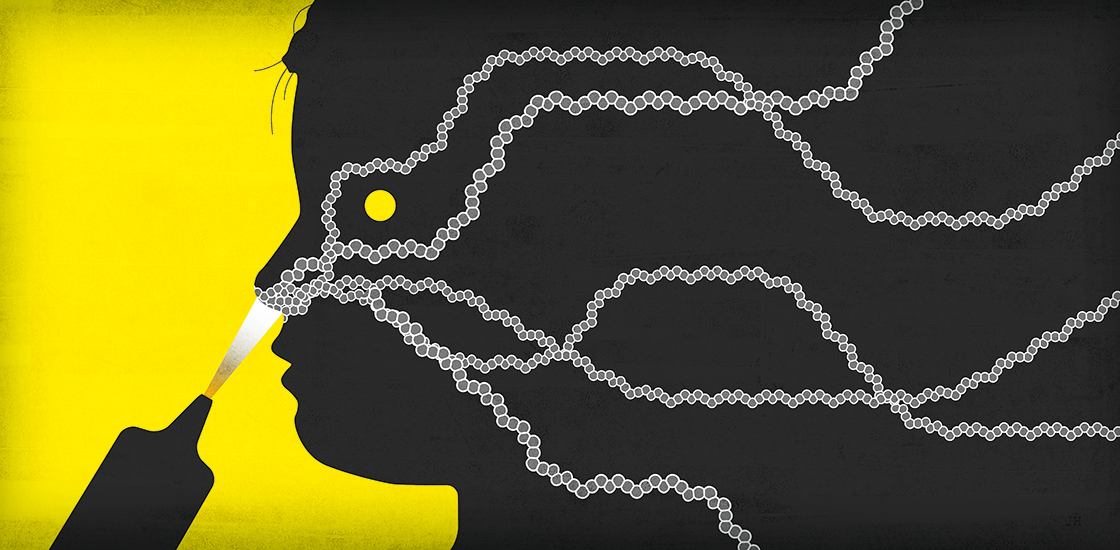How the social hormone vasopressin might help autistic people
A drug that mimics the hormone vasopressin improves social skills in autistic people — but so does one that blocks vasopressin’s effects. How can seemingly opposing manipulations produce similar results?

A wealth of research supports a role for the hormone vasopressin in social behavior. Also known as ‘antidiuretic hormone,’ vasopressin is a small peptide that regulates a variety of functions, such as thirst, water balance, blood pressure and social behavior.
Because of its effects on social behavior, the vasopressin system may offer therapeutic targets for easing social impairments in autism. Two clinical studies published this year showed promising results.
One study, published in May in Science Translational Medicine, suggested that delivering vasopressin via the nose increases social behavior scores in autistic children1. The other, in the same issue, revealed that blocking vasopressin with a pill called balovaptan modestly improves social and communication skills in autistic adults2.
At face value, this presents a conundrum. How can seemingly opposite manipulations — one mimicking vasopressin and one blocking it — induce similar outcomes?
Methodological differences between the two studies offer some clues and possible explanations. Analyzing the studies in tandem also offers up new research questions to explore around the topic of vasopressin and social behavior.
Age difference:
The age of the participants in the studies differs: One study was in children and the other in adults. Children are not just small adults, and we cannot assume that drugs have the same effects at all ages. In fact, treating children with intranasal vasopressin produced a large effect on social behavior, whereas treating adults with an oral vasopressin blocker produced a small change.
Perhaps the vasopressin system plays one role during development — such that children need more vasopressin signaling for prosocial behavior — and a quite different role in adulthood.
Another possible explanation is that the drugs, as administered in the studies, acted on different parts of the body. Spraying vasopressin into the nose may act locally or may cross into the brain. Our unpublished research in rodents shows that vasopressin receptors are present in the mouth and nose and could convey information to the brain.
By contrast, the drug balovaptan, given orally, is absorbed into the bloodstream and delivered throughout the body, including the brain. We usually think of the behavioral effects of drugs as being mediated in the brain; however, vasopressin has known actions on peripheral tissues, which could indirectly influence behavior. For example, it has become clear that the hormone acts in the periphery to induce feelings of arousal3.
Overall, it is still unclear whether peripherally applied vasopressin drugs affect behavior by acting in the periphery, in the brain or both.
Indirect actions:
The two treatments also may differ in how they interact with the four types of receptors that bind to vasopressin and convey its message4. Three of the receptors, V1a, V1b and the oxytocin receptor have known roles in regulating social behavior. (The fourth, called V2, regulates kidney function.) Like vasopressin produced in the body, vasopressin delivered intranasally may bind to all four of these receptors.
By contrast, the vasopressin blocker balovaptan binds selectively to just one vasopressin receptor — V1a. Perhaps blocking one receptor type forces the normally circulating vasopressin to act on other receptors to promote prosocial effects. In this scenario, balovaptan would indirectly increase overall vasopressin activity at the three remaining receptors.
As a next step, researchers need to replicate these initial studies. They also need to make sure that these treatments are safe by watching out for side effects in larger trials.
Researchers also need to determine how vasopressin affects social behavior at different stages of development and in different behavioral contexts. We need to determine the roles of sites in the brain and periphery in vasopressin’s actions and which receptor types mediate vasopressin’s prosocial effects. For instance: What happens if the vasopressin V1a receptor is blocked at the same time that extra vasopressin is given?
A better understanding of how vasopressin works in the body may ultimately lead to better treatments.
Elizabeth Hammock is assistant professor of psychology at Florida State University.
References:
Recommended reading

Too much or too little brain synchrony may underlie autism subtypes

Developmental delay patterns differ with diagnosis; and more

Split gene therapy delivers promise in mice modeling Dravet syndrome
Explore more from The Transmitter

During decision-making, brain shows multiple distinct subtypes of activity

Basic pain research ‘is not working’: Q&A with Steven Prescott and Stéphanie Ratté
